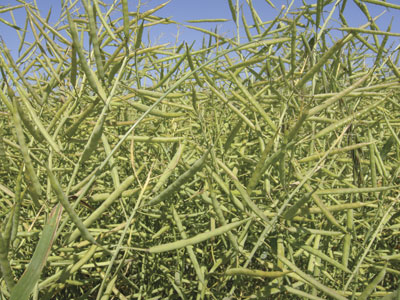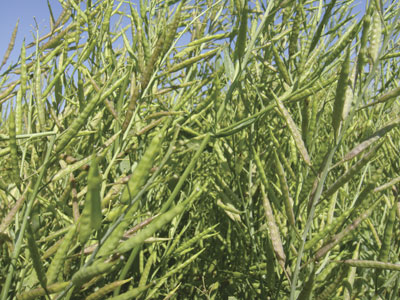
News
Shatter-proof canola is the Holy Grail
Many producers prefer to straight combine the majority of their crops. However, straight combining canola is still considered fairly risky due to pod shattering and pod drop losses.
October 20, 2009 By Donna Fleury
Many producers prefer to straight combine the majority of their crops. However, straight combining canola is still considered fairly risky due to pod shattering and pod drop losses. “We know that producers from across the province are interested in eventually being able to confidently straight combine canola along with their other crops,” says Pat Flaten, research manager with SaskCanola. “However, straight combining canola is still considered a risky venture and we’re advising people to be cautious. There just isn’t nearly as much flexibility with canola as with other crops.”

|
|
| Canola shattering loss trials at the Indian Head Agri-ARM site in August 2009, with variety RR 4362 plot in the foreground. All photos courtesy of Chris Holzapfel, IHARF. |
New pod sealant products have been introduced recently into Canada. If effective, pod sealants have the potential to increase the length of time that canola can be left standing, increasing harvest flexibility and allowing producers to fully capture the benefits of straight combining. However, research evaluating the performance of these products for canola in Western Canada has been limited. “These products have been used primarily in Europe in canola, and so far there haven’t been very certain positive results on the limited research in North America,” explains Flaten. Recent research conducted in North Dakota did not show any benefit to applying pod sealants when straight harvesting canola with respect to grain yield or shattering losses. “There are some suggestions that pod sealants may be challenging because of dry, windy conditions, so caution is advised.”
Pod sealant evaluation started in 2009
In an effort to get more information on the risks of pod shattering from straight combining and the potential benefits of using pod sealant products, SaskCanola initiated a new project in 2009 in collaboration with four Saskatchewan Agri-ARM (Agriculture-Applied Research Management) sites. “The objective of the study is to evaluate the ability of two currently available pod sealant products, Pod Ceal DC and Pod-Stik to reduce shattering losses and increase grain yields in several cultivars of direct combined canola,” explains Chris Holzapfel, researcher and project lead with the Indian Head Agricultural Research Foundation. “We are also trying to assess whether there are varietal differences in pod shattering.” Other AgriARM partners include Wheatland Conservation Area Inc., Western Applied Research Corporation and the North East Agriculture Research Foundation.
 |
|
| Industry canola standard InVigor 5020. | |
 |
|
| XCEED 8571 juncea canola, the shatter-resistant canola standard. |
The study is comparing four harvest management treatments on five different cultivars at four locations: Indian Head, Melfort, Scott and Swift Current. Three top-yielding canola varieties were selected, along with InVigor 5020 as an industry standard and XCEED 8571 juncea canola as a shatter-resistant standard. The harvest treatments include swathing, untreated straight combining and straight combining using pod sealants, comparing Pod-Stik and Pod Ceal DC.
Several parameters will be measured, including plant density, lodging, days to maturity, grain yield, percent green seed, seed size, seed oil content, visual shatter ratings and yield losses due to pod shattering and pod drop. “We will be directly measuring shattering in all of the straight cut treatments by placing trays beneath the crop canopy,” explains Holzapfel. “We will physically measure any losses and differentiate between losses due to shattering and losses due to pod drop.”
“Researchers at Agriculture and Agri-Food Canada (AAFC) in Saskatoon are also working on developing shatter resistance traits in canola and we want to see those efforts continue,” adds Flaten. “Although the work is preliminary, an earlier AAFC study did show that varieties do differ in their shatter resistance.” Pod shatter susceptibility was investigated in Brassica napus germplasm and shatter resistant species of B. juncea and Sinapis alba. Yield loss caused by pod shatter ranged from a low of four percent for the B. juncea to a high of 51 percent for some black seeded B. napus line in two-year field trials after one month maturity. “Growers who are interested in straight combining and are in the right area could consider growing juncea canola, which is a canola quality seed but brings along mustard quality standability, heat and shatter resistance,” says Flaten. “Another option is to select Polish or B. rapa canola varieties, which are also less likely to shatter.”
While B. rapa and B. juncea species are generally more resistant to shattering than B. napus species, they tend to yield less. “Some B. napus cultivars are also less prone to shattering than others, and we will be comparing the cultivars used in the study.”
Use on-farm pod sealant cautiously
For growers who want to try pod sealants, start small and make sure to leave check strips for comparison. Although there are no independent, third party recommendations currently available for pod sealants, there are certain fields and conditions that are better suited for straight cutting and trialing pod sealant products. “Choose fields that are relatively dense, with an even well-knitted or interwoven crop canopy, even maturity and slightly lodged,” explains Holzapfel. “Crop uniformity is quite a challenge this year across many parts of Western Canada. There are a few growers who are assessing whether or not to try pod sealants on crops they plan to swath because some plants are quite ripe while others are just finishing flowering. This could still be a sound application for these situations.”
For the SaskCanola research project, preliminary research results are expected to be available during upcoming winter meetings, and the full first year of results should be available in early spring 2010 through SaskCanola and the four Agri-ARM sites at Indian Head, Melfort, Scott and Swift Current.